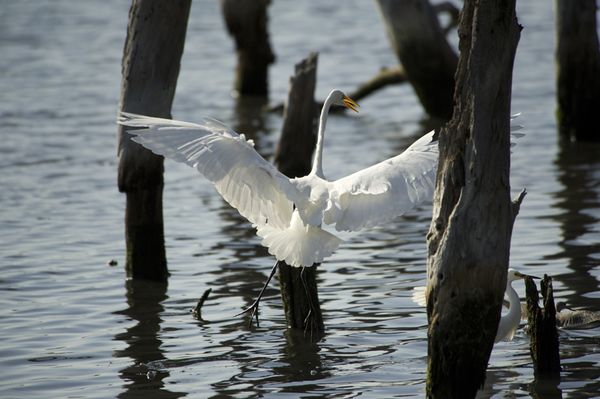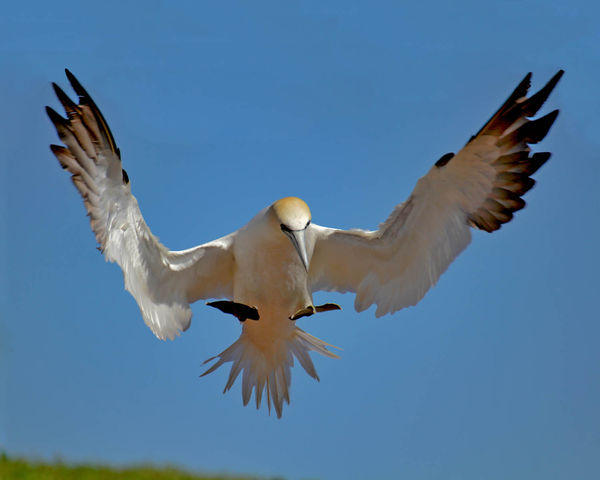Atten wildlife photographers
Dec 3, 2011 17:04:03 #
Is there any way of getting a good photo of a white swan / snow goose, on a sunny day, without blowing out their feathers?
or must I resort to either shooting at sunrise/sunset or during cloudy/overcast days.
I understand that white is very reflective and thus causes all kinds of problem, but is there some trick or camera setting that might improve my odds of getting a decent shot.
or must I resort to either shooting at sunrise/sunset or during cloudy/overcast days.
I understand that white is very reflective and thus causes all kinds of problem, but is there some trick or camera setting that might improve my odds of getting a decent shot.
Dec 3, 2011 18:52:10 #
Bright lighting for birds particularly white birds is hard but it can be done.
Best method is to use manual exposure. Using any auto mode and the camera will almost always find a way to screw you, especially on those white birds.
You will need to expose for the white birds and don't worry about the background going dark. A dark background makes white birds pop out better anyway.
But of course early morning or early evening light is generally better for birds. Still go with manual exposure though.
Best method is to use manual exposure. Using any auto mode and the camera will almost always find a way to screw you, especially on those white birds.
You will need to expose for the white birds and don't worry about the background going dark. A dark background makes white birds pop out better anyway.
But of course early morning or early evening light is generally better for birds. Still go with manual exposure though.
Dec 3, 2011 19:05:15 #
Dec 3, 2011 19:13:29 #
Dec 3, 2011 19:56:23 #
Swamp Gator wrote:
Bright lighting for birds particularly white birds... (show quote)
Swamp gator,
I do shoot manual mode, and usually meter off the white feathers but adjust 2 stops (depending on amount of light in background) as I'm always concerned background will be under exposed.
Will take your advice and not worry about background and see how things look. Thank you.
btw: took a peek at your website and all I can say is, Wow! you've got some really awesome shots.
ckcougar - I checked my camera settings and I also have a mode for snow. I tried it, it worked . . . . we got 3" of snow :-)
Seriously, I will give it a shot, I'm curious to see what settings are modified in camera to adjust for the effect of bright white snow.
Dec 4, 2011 06:56:11 #
If the white animal is sitting perfectly still you could try HDR. That really brings out details in both highlight and shadow areas but you must have a static subject.
Dec 4, 2011 06:56:14 #
Given you camera has Exposure Compensaiton adjsutm,ent, increase to +1 or +2. Seems conunterintuitive, but hats how you overcome the camera's tendency to reduce white ot gray
Dec 4, 2011 07:39:05 #
Depending on what model your camera is -- the "snow" setting is usually found under the "SCN" on your camera dial -- once the dial is set to that, then just slowly turn or scroll right or left until you find it.
I'm more familiar with Canon cameras and that's where my "snow" setting is. I'm not too familiar with Nikon cameras. You should also see these settings: beach, fireworks, miniature, fisheye, just to name a few. If you have "fisheye" effect, play with that one a bit too, you can get the same result as if you had an actual "fisheye" lens on your camera. You can choose low, med or high for the degree of the fisheye curve you want. Hope the explanations help.
I'm more familiar with Canon cameras and that's where my "snow" setting is. I'm not too familiar with Nikon cameras. You should also see these settings: beach, fireworks, miniature, fisheye, just to name a few. If you have "fisheye" effect, play with that one a bit too, you can get the same result as if you had an actual "fisheye" lens on your camera. You can choose low, med or high for the degree of the fisheye curve you want. Hope the explanations help.
Dec 4, 2011 08:47:54 #
This is an old trick used by many photographers. Hold you hand in front of the lens. (ten or so inches) Take a reading. Use that reading for the shot.
Or you can use a 'gray card' if you have one.
Or you can use a 'gray card' if you have one.
Dec 4, 2011 09:35:14 #
sirlensalot
Loc: Arizona
I think the starting point is to increase EC minimally depending on surrounding lighting then adjust using histogram.
I usually start with +2/3 and go from there. Good luck!
I usually start with +2/3 and go from there. Good luck!
Dec 4, 2011 10:13:20 #
For H.D.R. you also must take several shots at different exposures. (shutter-not aperture). And you have to use a tripod.
Might have a little trouble getting that bird to stand still that long.
Might have a little trouble getting that bird to stand still that long.
Dec 4, 2011 10:20:19 #
Dec 4, 2011 10:49:25 #
I have been successful at putting my camera's meter on center weight or spot and using aperature priority. I shoot in raw setting or NEF for Nikon. It's easier to do post processing on those birds and darken the picture until you bring the detail back into the feathers. Here is a picture of a Great Egret I took two days ago. As long as nothing is blown out, I am happy. I agree, Swamp Gator has some fantastic pictures. Maybe someday (sigh).

Dec 4, 2011 12:11:14 #
Nice shot but to me the ripples in the water seems to take your eyes off of the bird.
Dec 4, 2011 12:13:42 #
Great advice SONTOG, and nice pic too
RAW pictures will have more latitude and SPOT metering will also help, I have had good luck with polarizer filters too.
RAW pictures will have more latitude and SPOT metering will also help, I have had good luck with polarizer filters too.

If you want to reply, then register here. Registration is free and your account is created instantly, so you can post right away.










